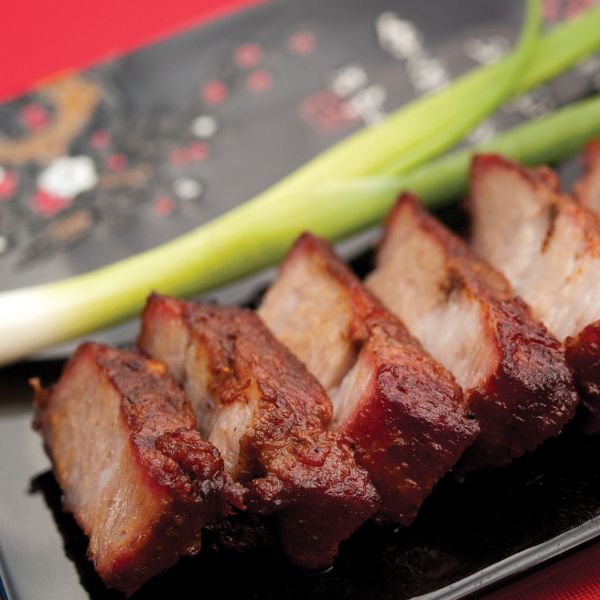SERVES 8 to 12
I love nouns that are also verbs, words like cheer, smile, mug, and potentially my favorite, fork. In Cantonese, char siu literally means “fork roast,” in reference to the traditional cooking method for this tangy-sweet BBQ pork, which involves piercing strips of pork with a fork and roasting until they’re tender and caramelized. This Chinese restaurant classic is usually seasoned with sugary, no-no ingredients like hoisin sauce, honey, brown sugar, and soy sauce. My marinade uses substitutions with minimal sugar and plenty of flavor. This recipe is not difficult, but it demands your attention near the end. You’ll forgive its neediness with your first bite of its sticky-crisp glaze.
INGREDIENTS
• 4 pounds boneless pork shoulder
MARINADE:
• 1/2 cup coconut aminos
• 1 dried date
• 3 cloves garlic, roughly chopped (about 1 1/2 tablespoons)
• 1/4 cup unsweetened apple sauce
• 1 teaspoon rice vinegar
• 1 tablespoon sunflower seed butter or almond butter (no sugar added)
• 4 teaspoons sesame oil
• 1/4 teaspoon crushed red pepper flakes
• 1 1/2 teaspoons powdered ginger
• 1 teaspoon Chinese five-spice powder
• 1/4 teaspoon ground black pepper
BBQ GLAZE:
• 1/4 cup tomato paste
• 1/3 cup unsweetened apple sauce
• 1/2 tablespoon rice vinegar
DIRECTIONS
1. Cut the pork into 8 strips: Cut the shoulder in half lengthwise, then lay each half on its cut side, and slice lengthwise into 4 equal-sized strips. Trim off excess or hard fat. Poke each of the strips 10-12 times with a fork, then place the strips in a large zipper storage bag.
2. Place all the ingredients for the marinade in the food processor and process until combined. Measure 1/2 cup of the marinade and set it aside to use in the BBQ glaze later. Pour the rest of the marinade over the pork in the zipper bag. Squeeze out the excess air, seal the bag, and place in the fridge for 30 minutes to 4 hours. Flip the bag every once in a while so all sides of the meat are coated in the marinade.
3. While the pork is marinating, make the BBQ glaze. In a small saucepan, combine the 1/2 cup reserved marinade, tomato paste, apple sauce, and rice vinegar. Cook over medium heat, stirring with a wooden spoon until the sauce begins to thicken, about 4-6 minutes. You should end up with about 1 cup of sauce.
4. When you’re almost ready to remove the meat from the marinade, preheat the oven to 300 F. Cover a large rimmed baking sheet or pan with aluminum foil, then set a wire rack on the pan; pour 1/4 cup water into the pan.
5. Remove the pork from the marinade and place on the rack, then cover the entire pan with aluminum foil, crimping the edges to form a seal. Roast the pork for 20 minutes, then remove the foil and roast an additional 40–45 minutes – watch for the edges to begin to turn a lovely brown.
6. Increase the oven temperature to 500 F and roast for 8–12 minutes more, until it’s evenly browned. Carefully remove the pork from the oven and brush the tops and sides of the pieces with half the sauce. You want complete coverage with a thin layer so the sauce forms a glaze in the oven. As my dad would say, “Put it on like you’re taking it off.”
7. Return the pork to the oven for 6-8 minutes, until the sauce is a deep shade of burgundy. Remove the pan from the oven and use tongs to flip the pork. Brush the other side with sauce and return to the oven for the final 6-8 minutes.
8. Remove the pork from the oven and let it rest for 10 minutes, then cut cross-wise into 1/2-inch slices.
9. YOU KNOW HOW YOU COULD DO THAT?
10. Use a broiler: Instead of increasing oven temp to 500 F, you can use a broiler. Broil for 7-9 minutes before brushing with sauce, then broil 3-5 minutes per side after glazing.







